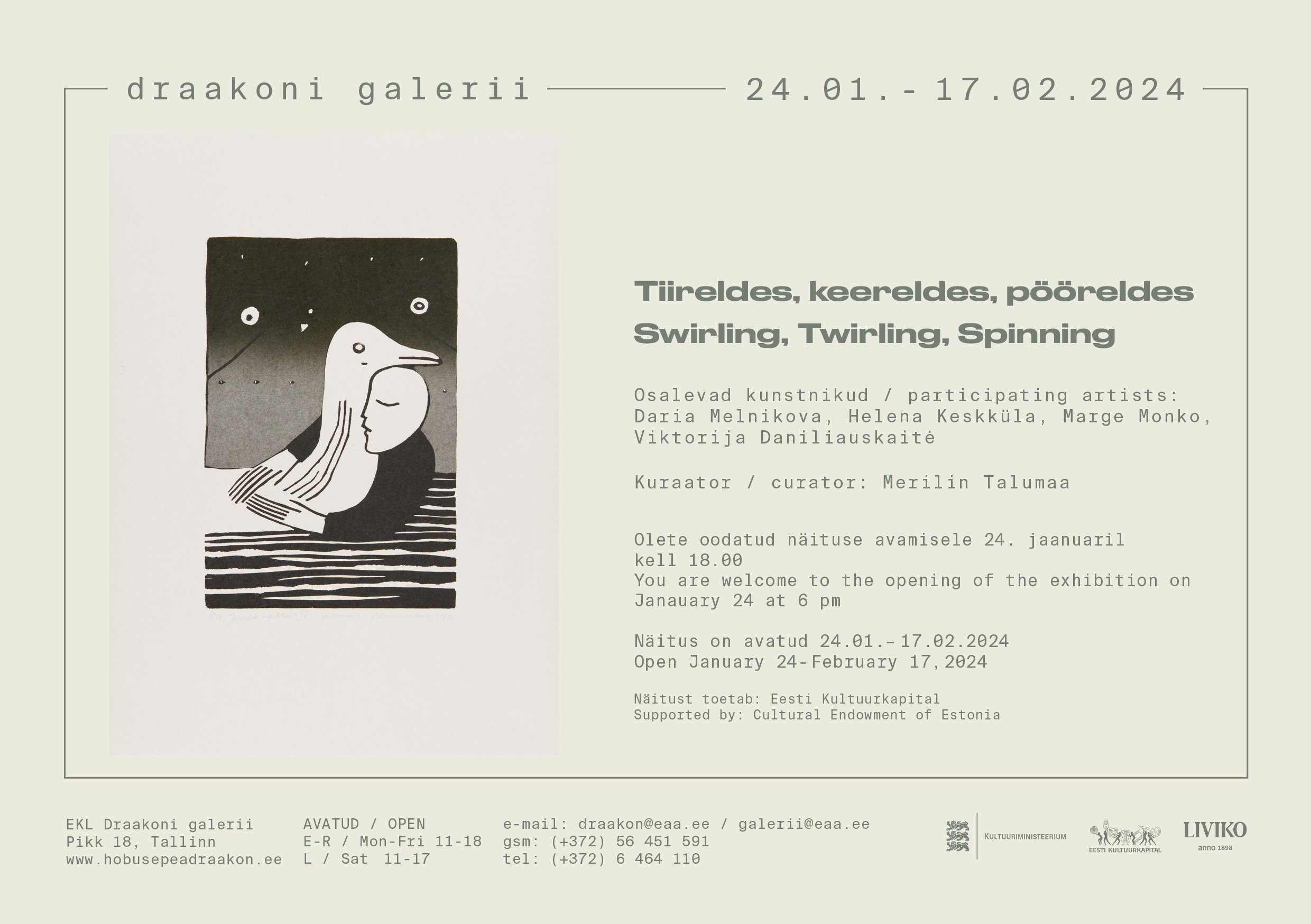Swirling, Twirling, Spinning
January 24–February 17, 2024
Draakoni Gallery
Pikk 18, Tallinn 10133, Estonia
Monday—Friday, 11am—6pm
Saturday, 11am–5pm
Free entrance
The exhibition Swirling, Twirling, Spinning unites artists across generations in an empowering context, drawing inspiration from the ideas of Lithuanian-American archaeologist and anthropologist Marija Gimbutas. Her profound research brought attention to the ancient cultures of the Baltic region and the broader Indo-European world, exploring archaeological artefacts, linguistics, ethnography, and folklore. Gimbutas posited a thesis that prehistoric European culture centred around the worship of a Mother Goddess, as the giver of all life. A spiritual sense of connectedness was artfully expressed through a sophisticated symbol system and an abundance of ritual objects. Nature and body were honoured in Europe for tens of thousands of years. Whereas women had an especially strong position in societies across Eastern and Central Europe – a tendency no longer necessarily evident today.
Swirling, Twirling, Spinning poetically weaves a narrative that bridges ancient myths and beliefs, natural cycles, and the transformative power of feminine energy across different cultures and times. Gimbutas, who having opened the treasure trove of prehistory, inspired a belief in a peaceful existence in our time – to bring back to life suppressed vital elements, such as the earth, the body (health), the feminine, and the subconscious. Participating artists, through imaginative and fictitious narratives, share personal stories and cultural myths that also reflect the influence of Gimbutas’ theories on ancient symbolism. Their works echo these concepts through a contemporary lens, incorporating elements such as spirals, circles, and motifs such as snakes and birds – symbols rooted in ancient European matriarchal cultures that continue to resonate in Baltic art and culture.
The exhibition contemplates on reimagining a world centred around goddess worship, with its emphasis on embracing womanhood, preserving nature, and forsaking warfare. Could this theoretical concept transcend into the tangible reality of our future society? Swirling, Twirling, Spinning seamlessly intertwines historical narratives and mythology, immersing us in the themes that Marija Gimbutas ignited: the celebration of life’s cycles, constant renewal, the sanctity of the female body, and the spirituality inherent in these concepts. Gimbutas’ exploration of the spiritual dimensions of a harmonious Old Europe and her vision for a New Europe free from dominance and warfare, feels remarkably pertinent in our contemporary world.
Participating artists: Daria Melnikova, Helena Keskküla, Marge Monko, Viktorija Daniliauskaitė
Curator: Merilin Talumaa
We would like to thank our partners and supporters: Draakoni Gallery, Cultural Endowment of Estonia, Mario Nurmelaid
First exhibition around the heritage of Marija Gimbutas took place in L’Atlas Gallery in Paris, France (7 November 2023–3 January 2024). The cycle of exhibitions is foreseen to continue with an upcoming show in La Traverse in Marseille, France (27 August–26 October 2024).
__________
Marija Gimbutas (1921–1994) was a Lithuanian-American archaeologist and anthropologist. She contributed to what is considered to be one of the most significant academic watershed moments in women’s studies with her archaeological and philosophical work on Neolithic culture and religion. Gimbutas is best known for her research into the Neolithic and Bronze Age cultures of “Old Europe,” a term she introduced. Old Europe referred to both the geographical area and social structures that existed before the Indo-European influence. Gimbutas unequivocally established the existence of a Goddess religion who is the most persistent feature in the archaeological record of the ancient world. The Goddess in all her manifestations was a symbol of the unity of all life in nature. Gimbutas’ discoveries took on great symbolic importance for feminists across various disciplines who found, in her vision of a peaceful, nature-revering society, a sense of hope for the future based on this foundation in the distant past.

